Stable channel - Study guides, Class notes & Summaries
Looking for the best study guides, study notes and summaries about Stable channel? On this page you'll find 2702 study documents about Stable channel.
All 2.702 results
Sort by
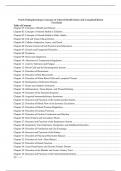 Popular
Popular
-
Test Bank Porth Pathophysiology Concepts of Altered Health States 2nd Canadian Edition
- Exam (elaborations) • 289 pages • 2023
-
- $17.99
- 5x sold
- + learn more
Test Bank Porth Pathophysiology Concepts of Altered Health States 2nd Canadian EditionTable of Contents Chapter 01: Concepts of Health and Disease .......................................................................................................... 2 Chapter 02: Concepts of Altered Health in Children ............................................................................................. 13 Chapter 03: Concepts of Altered Health in Older Adults ............................................
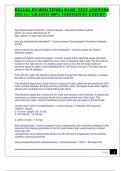 Popular
Popular
-
RELIAS DYSRHYTHMIA BASIC TEST ANSWERS 2024 (A+ GRADED 100% VERIFIED
- Exam (elaborations) • 24 pages • 2024 Popular
-
Available in package deal
-
- $5.99
- 3x sold
- + learn more
dysrhythmia aka arrhythmia - Correct answer - abnormal cardiac rhythms which can cause disturbances of: rate, rhythm, or both rate and rhythm how are dysrhythmias identified? - Correct answer Electrographic Waveform Analysis (ECG) what controls the rate and rhythm of the heartbeat? - Correct answer the heart's electrical system explain the heart's electrical system - Correct answer Each electrical signal (impulse) begins in a group of cells called the sinus node or sinoatrial (SA...
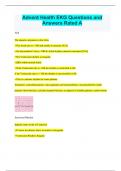
-
Advent Health EKG Questions and Answers Rated A
- Exam (elaborations) • 20 pages • 2023
- Available in package deal
-
- $13.28
- 4x sold
- + learn more
Afib The impulse originates in the Atria • The Atrial rate is > 300 and unable to measure [N/A] • No discernable P waves - PRI & Atrial rhythm cannot be measured [N/A] • The Ventricular rhythm is irregular • QRS within normal limits • If the Ventricular rate is <100 the rhythm is controlled A-fib; if the Ventricular rate is > 100 the rhythm is uncontrolled A-fib • This is a chronic rhythm for some patients Treatment: controlled patients: anticoagulants and antiarryt...
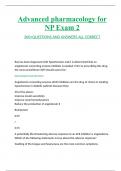
-
Advanced pharmacology for NP Exam 2 300+QUESTIONS AND ANSWERS ALL CORRECT
- Exam (elaborations) • 46 pages • 2023
- Available in package deal
-
- $9.49
- 2x sold
- + learn more
Advanced pharmacology for NP Exam 2 300+QUESTIONS AND ANSWERS ALL CORRECT Ray has been diagnosed with hypertension and it is determined that an angiotensin-converting enzyme inhibitor is needed. Prior to prescribing this drug, the nurse practitioner (NP) should assess for: Decreased renal function Angiotensin-converting enzyme (ACE) inhibitors are the drug of choice in treating hypertension in diabetic patients because they: All of the above: Improve insulin sensitivity Improve rena...
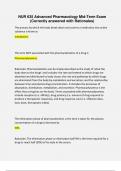
-
NUR 635 Advanced Pharmacology Mid-Term Exam (Correctly answered with Rationales)
- Exam (elaborations) • 13 pages • 2023
- Available in package deal
-
- $13.49
- 5x sold
- + learn more
The process by which the body break down and coverts a medication into active subtance is know as metabolism The term NOT associated with the pharmacokinetics of a drug is Pharmacodynamics R ationale: Pharmacokinetics can be simply described as the study of 'what the body does to the drugs' and includes: the rate and extend to which drugs are absorbed and distributed to body tissue; the rate and pathways by which drugs are eliminated from the body by metabolism and excretion; and the relations...
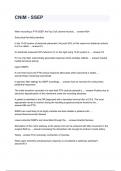
-
CNIM - SSEP When recording a PTN SSEP, the Fpz-Cs5 channel records... - answer-N34 Subcortical far-field potentials In the 10-20 system of electrode placement, the point 20% (of the nasion-ion distance) anterior to Cz is called... - answer-Fz An electrode
- Exam (elaborations) • 12 pages • 2024
-
Available in package deal
-
- $7.99
- 1x sold
- + learn more
CNIM - SSEP When recording a PTN SSEP, the Fpz-Cs5 channel records... - answer-N34 Subcortical far-field potentials In the 10-20 system of electrode placement, the point 20% (of the nasion-ion distance) anterior to Cz is called... - answer-Fz An electrode measured 20% lateral to Cz on the right using 10-20 system is... - answer-C4 P14 is a far-field, subcortically generated response which probably reflects... - answer-Caudal medial lemniscal activity Upper SSEPs If over three hours the ...
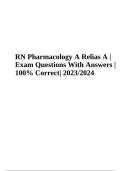
-
RN Pharmacology A Relias A | Exam Questions With Answers | 100% Correct| 2023/2024
- Exam (elaborations) • 43 pages • 2023
-
- $20.49
- 2x sold
- + learn more
RN Pharmacology A Relias A | Exam Questions With Answers | 100% Correct| 2023/2024. Potassium chloride 10 mEq intravenously has been ordered for a client whose potassium is 2.9 following diuretics. How will the nurse administer the potassium dose? A) Dilute the dose in a 50 ml IV rider and infused over 1 hour B) Push the dose as a rapid IV push because of the patient’s dangerously low potassium level C) Push the dose slowly over 10 minutes D) Ask to give the dose in a large muscle since t...
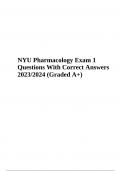
-
NYU Pharmacology Exam 1 (Questions With Correct Answers) 2023 Graded A+
- Exam (elaborations) • 37 pages • 2023
-
- $22.49
- 4x sold
- + learn more
NYU Pharmacology Exam 1 (Questions With Correct Answers) 2023 Graded A+. Induces INC intracelluar sodium drives Ca into heart and INCREASE CONTRACTILITY AE: -bradycardia -dysrhythmias -anorexia, N/V -headache -blurred or yellow vision TOXICITY: - anorexia, N/V, green or yellow halos, bradycardia premature ventricular contractions, cardiac dysrhythmias, confusion, delirium for elderly R4 toxicity: - low K+ -renal failure -loop diuretics -Hypercalcemia Considerations: - pulse full ...
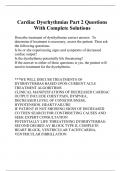
-
Cardiac Dysrhythmias Part 2 Questions With Complete Solutions
- Exam (elaborations) • 24 pages • 2023
-
Available in package deal
-
- $10.99
- 1x sold
- + learn more
Describe treatment of dysrhythmias correct answer: To determine if treatment is necessary, assess the patient. Then ask the following questions: Is he or she experiencing signs and symptoms of decreased cardiac output? Is the dysrhythmia potentially life threatening? If the answer to either of these questions is yes, the patient will need to treatment for the dysrhythmia. ***WE WILL DISCUSS TREATMENTS OF DYSRHYTHMIAS BASED UPON CURRENT ACLS TREATMENT ALGORITHMS CLINICAL MANIFESTATIONS ...
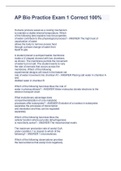
-
AP Bio Practice Exam 1 Correct 100%
- Exam (elaborations) • 9 pages • 2023
-
Available in package deal
-
- $13.49
- 4x sold
- + learn more
Humans produce sweat as a cooling mechanism to maintain a stable internal temperature. Which of the following best explains how the properties of water contribute to this physiological process? - ANSWER The high heat of vaporization of water allows the body to remove excess heat through a phase change of water from liquid to gas A student placed a semipermeable membrane inside a U-shaped channel with two chambers, as shown. The membrane permits the movement of water but not salt. The...
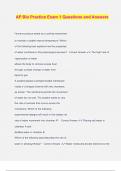
-
AP Bio Practice Exam 1 Questions and Answers
- Exam (elaborations) • 16 pages • 2024
- Available in package deal
-
- $12.49
- 1x sold
- + learn more
AP Bio Practice Exam 1 Questions and Answers Humans produce sweat as a cooling mechanism to maintain a stable internal temperature. Which of the following best explains how the properties of water contribute to this physiological process? - Correct Answer ️️ -The high heat of vaporization of water allows the body to remove excess heat through a phase change of water from liquid to gas A student placed a semipermeable membrane inside a U-shaped channel with two chambers, as shown. ...

How did he do that? By selling his study resources on Stuvia. Try it yourself! Discover all about earning on Stuvia


